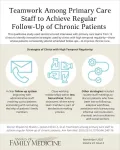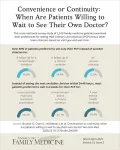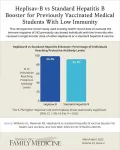(Press-News.org) Original Research
Background and Goal: Regular follow-up visits are critical for managing chronic conditions, yet some primary care clinics achieve higher visit regularity than others. This study aimed to identify specific strategies used by high-performing clinics to promote consistent follow-up visits for adults with chronic conditions.
Study Approach: This qualitative study used semi-structured interviews with 15 primary care physicians, 12 nurses, 15 administrative staff, and 4 pharmacists from 12 clinics—half with high temporal regularity (patients attending follow-ups consistently) and half with low temporal regularity, identifying strategies that helped high–temporal regularity clinics maintain regular chronic care visits.
Main Results: Clinics with high temporal regularity shared key teamwork strategies that distinguished them from low–temporal regularity clinics:
Close working relationships with less hierarchical staff structures where every team member is part of the decision-making process
Staff members described a clear system to ensure follow-up for “no show” patients, beginning with administrative staff reaching out to patients and ending with recruiting the help of patients’ family members
Additional innovative strategies, including routine staff meetings, adaptive workflows, assisting patients with bureaucracy, informal communication channels, and consulting social workers
Why It Matters: This study highlights how team-based strategies—including structured follow-up systems, proactive patient outreach, and interdisciplinary collaboration—can improve regular follow-up for patients with chronic conditions.
Teamwork Among Primary Care Staff to Achieve Regular Follow-Up of Chronic Patients
Maram Khazen, PhD, et al
Braun School of Public Health and Community Medicine, Faculty of Medicine, Hebrew University of Jerusalem, Jerusalem, Israel
Department of Health Systems Management, the Max Stern Yezreel Valley College, Jezreel Valley, Israel
PERMANENT LINK
Visual Abstract
END
Shared decision making among primary care clinic staff and family involvement improves follow-up for chronic patients
Teamwork among primary care staff to achieve regular follow-up of chronic patients
2025-03-24
ELSE PRESS RELEASES FROM THIS DATE:
Over half of patients prefer their own doctor and will wait longer for an appointment
2025-03-24
Original Research
Background and Goal: This study focuses on how primary care patients balance the trade-off between continuity of care and access to timely appointments. It examines whether patients prefer to wait longer to see their own primary care physician (PCP) or prefer to see another clinician for faster care.
Study Approach: Researchers analyzed data from a cross-sectional online survey of adult primary care patients in Michigan. Patients were presented with scenarios in the survey for different visit types—annual checkups, chronic and mental health follow-ups, ...
Newer hepatitis B vaccine shows promise as booster for health care workers
2025-03-24
Research Brief
Background and Goal: Health care workers are at higher risk of hepatitis B infection due to occupational exposure to blood and body fluids. They are considered protected if they have a hepatitis B surface antigen antibody (anti-HBs) titer of ≥10 mIU/mL after completing a full vaccination series. This study compared the effectiveness of Heplisav-B, a new hepatitis vaccine, vs. standard hepatitis B vaccines as a booster in previously vaccinated individuals.
Study Approach: Researchers ...
Family-based lifestyle intervention improves weight management and cardiovascular health among high-risk patients
2025-03-24
Original Research
Family-Based Lifestyle Intervention Improves Weight Management and Cardiovascular Health Among High-Risk Patients
Background and Goal: The PROgramme of Lifestyle Intervention in Families for Cardiovascular risk reduction (PROLIFIC) Study, conducted in India, aimed to assess whether a family-based approach to lifestyle interventions could improve weight management and obesity-related health outcomes among individuals with a family history of premature coronary heart disease.
Study ...
Long-term inhaled corticosteroid use for COPD linked to serious long-term health risks
2025-03-24
Background and Goal: Inhaled corticosteroids (ICS) are commonly prescribed for chronic obstructive pulmonary disease (COPD), but not recommended as first-line treatment unless patients have asthma/COPD overlap or frequent exacerbations. This study examined whether long-term ICS use (more than two years) increases the risk of serious health conditions compared with short-term use (less than 4 months).
Study Approach: Researchers analyzed electronic health records from over 20 million patients, focusing on individuals aged 45 and ...
Ambulatory antibiotic use in France showed significant decline during the COVID-19 pandemic
2025-03-24
Research Brief
Background and Goal: The COVID-19 pandemic and lockdown measures in France affected health care access and prescribing patterns, leading to significant changes in outpatient (ambulatory) antibiotic use. This study examined how systemic antibiotic use in France changed from 2020 to 2022 compared to expected trends.
Study Approach: Researchers used nationwide health insurance data covering 67 million people to track monthly antibiotic prescriptions from January 2010 to March 2022. ...
Many patients with chlamydia and gonorrhea are not receiving CDC-recommended treatment in primary care
2025-03-24
Original Research
Background and Goal: Prompt treatment of chlamydia and gonorrhea following a confirmed diagnosis is essential to prevent complications and reduce transmission. Adherence to the Centers for Disease Control (CDC) treatment guidelines in primary care settings remains a concern. This study aimed to quantify the overall treatment rate for chlamydia and gonorrhea and identify factors associated with treatment delays and disparities.
Study Approach: Researchers analyzed electronic health record data from the PRIME registry, which includes information ...
“About me” care card tool can improve care planning and cognitive health management
2025-03-24
Original Research
Background and Goal: Existing tools for cognitive impairment focus primarily on clinical diagnosis but do not support discussions that address patients’ personal fears, goals, and social needs.
Study Approach: Researchers conducted a feasibility study using a community and user-centered design approach to develop and test the “About Me” Care Card, a tool developed based on shared decision-making principles. An environmental scan identified gaps in existing cognitive care tools, and a global steering committee made up of health care professionals, patient advocacy groups, ...
Chi, Advincula named Materials Research Society Fellows
2025-03-24
Miaofang Chi and Rigoberto “Gobet” Advincula, both researchers at the Department of Energy’s Oak Ridge National Laboratory, have been elected as Class of 2025 Fellows of the Materials Research Society, or MRS. Chi also holds a joint appointment at Duke University, and Advincula is jointly appointed at the University of Tennessee, Knoxville.
The society, which has more than 13,000 members from 90 countries, selects Fellows for their distinguished accomplishments and outstanding contributions ...
Expectant and new fathers seek more support to improve maternal health
2025-03-24
PHILADELPHIA (March 24, 2025) – A new Penn Nursing study reveals that expectant and new fathers, particularly Black American fathers, express a significant need for more resources and support to better assist mothers during pregnancy and childbirth. The research, published in BMC Pregnancy and Childbirth, highlights a gap in tailored information and resources for fathers within healthcare and social service systems.
Researchers conducted focus groups with eighty new fathers across the United States, with the majority (86%) being Black American, to understand ...
5,700-year storm archive shows rise in tropical storms and hurricanes in the Caribbean
2025-03-24
FRANKFURT. In the shallow waters of the Lighthouse Reef Atoll, located 80 kilometers off the coast of the small Central American country of Belize, the seabed suddenly drops steeply. Resembling a dark blue eye surrounded by coral reefs, the “Great Blue Hole” is a 125-meter-deep underwater cave with a diameter of 300 meters, which originated thousands of years ago from a karst cave located on a limestone island. During the last ice age, the cave’s roof collapsed. As ice sheets melted and global sea level started to rise, the cave ...
LAST 30 PRESS RELEASES:
Duke and Duke-NUS’ joint cross-population research to uncover "East-West" differences in disease and care
Scientists to ‘spy’ on cancer- immune cell interactions using quantum technology breakthrough
Tech savvy users have most digital concerns
Making lighter work of calculating fluid and heat flow
Normalizing blood sugar can halve heart attack risk
Lowering blood sugar cuts heart attack risk in people with prediabetes
Study links genetic variants to risk of blinding eye disease in premature infants
Non-opioid ‘pain sponge’ therapy halts cartilage degeneration and relieves chronic pain
AI can pick up cultural values by mimicking how kids learn
China’s ecological redlines offer fast track to 30 x 30 global conservation goal
Invisible indoor threats: emerging household contaminants and their growing risks to human health
Adding antibody treatment to chemo boosts outcomes for children with rare cancer
Germline pathogenic variants among women without a history of breast cancer
Tanning beds triple melanoma risk, potentially causing broad DNA damage
Unique bond identified as key to viral infection speed
Indoor tanning makes youthful skin much older on a genetic level
Mouse model sheds new light on the causes and potential solutions to human GI problems linked to muscular dystrophy
The Journal of Nuclear Medicine ahead-of-print tip sheet: December 12, 2025
Smarter tools for peering into the microscopic world
Applications open for funding to conduct research in the Kinsey Institute archives
Global measure underestimates the severity of food insecurity
Child survivors of critical illness are missing out on timely follow up care
Risk-based vs annual breast cancer screening / the WISDOM randomized clinical trial
University of Toronto launches Electric Vehicle Innovation Ontario to accelerate advanced EV technologies and build Canada’s innovation advantage
Early relapse predicts poor outcomes in aggressive blood cancer
American College of Lifestyle Medicine applauds two CMS models aligned with lifestyle medicine practice and reimbursement
Clinical trial finds cannabis use not a barrier to quitting nicotine vaping
Supplemental nutrition assistance program policies and food insecurity
Switching immune cells to “night mode” could limit damage after a heart attack, study suggests
URI-based Global RIghts Project report spotlights continued troubling trends in worldwide inhumane treatment
[Press-News.org] Shared decision making among primary care clinic staff and family involvement improves follow-up for chronic patientsTeamwork among primary care staff to achieve regular follow-up of chronic patients





